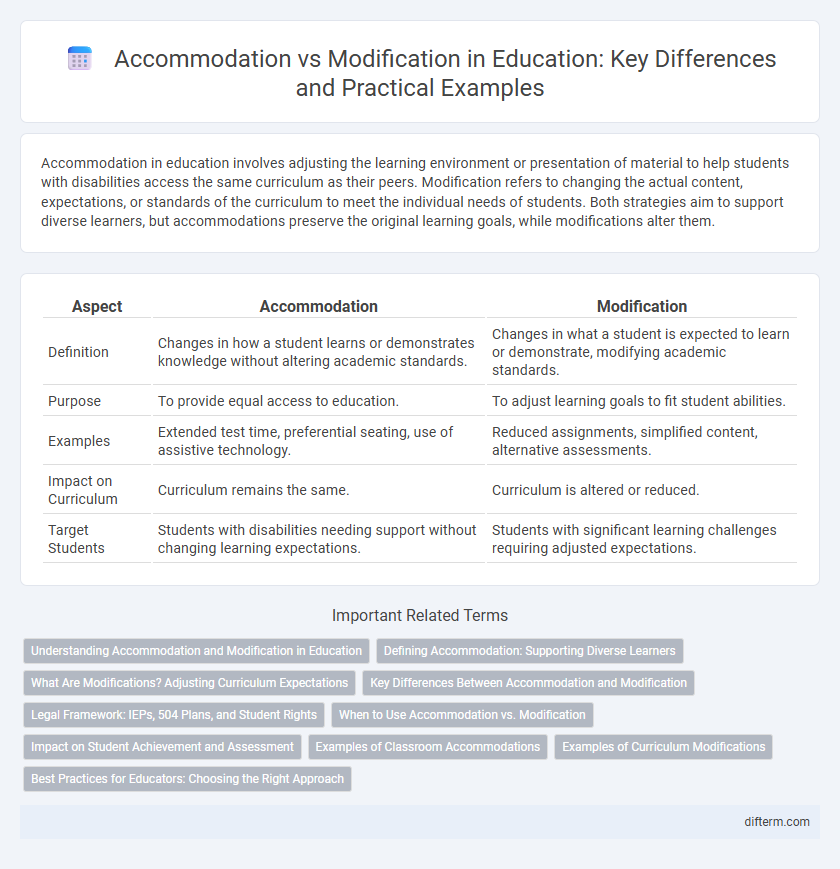Accommodation in education involves adjusting the learning environment or presentation of material to help students with disabilities access the same curriculum as their peers. Modification refers to changing the actual content, expectations, or standards of the curriculum to meet the individual needs of students. Both strategies aim to support diverse learners, but accommodations preserve the original learning goals, while modifications alter them.
Table of Comparison
| Aspect | Accommodation | Modification |
|---|---|---|
| Definition | Changes in how a student learns or demonstrates knowledge without altering academic standards. | Changes in what a student is expected to learn or demonstrate, modifying academic standards. |
| Purpose | To provide equal access to education. | To adjust learning goals to fit student abilities. |
| Examples | Extended test time, preferential seating, use of assistive technology. | Reduced assignments, simplified content, alternative assessments. |
| Impact on Curriculum | Curriculum remains the same. | Curriculum is altered or reduced. |
| Target Students | Students with disabilities needing support without changing learning expectations. | Students with significant learning challenges requiring adjusted expectations. |
Understanding Accommodation and Modification in Education
Accommodation in education involves adapting the learning environment or materials to support students' individual needs without altering the academic expectations, such as providing extended time on tests or preferential seating. Modification refers to changes in the curriculum or assessment standards to meet a student's unique abilities, often involving simplified assignments or alternative grading criteria. Understanding these distinctions helps educators tailor instruction effectively to enhance student access and success.
Defining Accommodation: Supporting Diverse Learners
Accommodation involves providing tailored support that enables diverse learners to access the same curriculum and demonstrate their knowledge without altering the learning expectations. Examples include extended time on tests, preferential seating, and assistive technology, all designed to address individual needs while maintaining academic standards. This approach ensures equitable learning opportunities by removing barriers without changing the core content or learning goals.
What Are Modifications? Adjusting Curriculum Expectations
Modifications involve altering curriculum expectations by changing what a student is expected to learn or demonstrate, often simplifying assignments or reducing the complexity of tasks to meet individual needs. These adjustments differ from accommodations, which support access without lowering standards, as modifications redefine learning goals tailored to a student's abilities. Examples include reducing the number of questions on a test or modifying the content to focus on essential skills rather than grade-level standards.
Key Differences Between Accommodation and Modification
Accommodation involves adjustments that help students access the same curriculum without altering learning expectations, such as extended time or alternative formats. Modification changes the curriculum or learning targets to match students' abilities, often simplifying content or reducing the complexity of assignments. Key differences lie in the level of change: accommodations maintain grade-level standards, while modifications alter academic requirements to provide appropriate support.
Legal Framework: IEPs, 504 Plans, and Student Rights
Accommodation and modification differ legally within educational frameworks such as Individualized Education Programs (IEPs) and Section 504 Plans, which are designed to protect student rights under the Individuals with Disabilities Education Act (IDEA) and the Rehabilitation Act, respectively. Accommodations adjust how a student accesses learning materials and demonstrates knowledge without altering the instructional level, whereas modifications change the content or expectations to better suit the student's needs. Both IEPs and 504 Plans ensure students with disabilities receive appropriate support, but IEPs specifically involve tailored modifications aligned with a student's unique educational needs under IDEA.
When to Use Accommodation vs. Modification
Accommodation is used when students need support to access the same curriculum as their peers without changing learning expectations, such as extended time on tests or preferential seating. Modification involves altering the curriculum or grading standards to meet the student's unique needs, applicable when a student cannot meet grade-level expectations even with support. Decisions between accommodation and modification depend on individualized education program (IEP) goals, assessment data, and the student's ability to demonstrate understanding.
Impact on Student Achievement and Assessment
Accommodations in education provide students with equal access to learning by altering the environment or presentation without changing the curriculum, supporting accurate assessment of student achievement. Modifications adjust the curriculum's content or expectations, which can significantly affect assessment outcomes by measuring different learning goals. Understanding the impact of accommodations versus modifications helps educators tailor support to enhance student performance while maintaining valid evaluation standards.
Examples of Classroom Accommodations
Classroom accommodations include providing extended time on tests, preferential seating to reduce distractions, and the use of assistive technology such as speech-to-text software. Other examples are allowing breaks during lessons, offering audio versions of textbooks, and providing graphic organizers to help with learning. These strategies support students' access to the curriculum without altering the content or expectations.
Examples of Curriculum Modifications
Curriculum modifications include reducing the complexity of assignments, such as simplifying reading materials or using alternative assessments like oral presentations instead of written reports. Modifications may also involve adjusting learning objectives, for example, focusing on basic math operations rather than advanced problem-solving for students with learning disabilities. These tailored changes ensure students meet individualized education program (IEP) goals while accessing core content at an appropriate level.
Best Practices for Educators: Choosing the Right Approach
Educators should evaluate individual student needs by distinguishing between accommodations, which provide equal access without altering learning expectations, and modifications, which change the curriculum or performance criteria to match student abilities. Implementing evidence-based strategies such as Universal Design for Learning (UDL) enables tailored support that fosters inclusion and academic growth. Continuous collaboration with specialists and families ensures the approach selected promotes student engagement and success while maintaining rigorous educational standards.
accommodation vs modification Infographic

 difterm.com
difterm.com